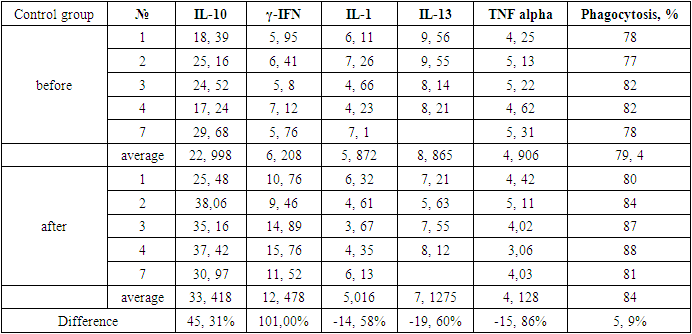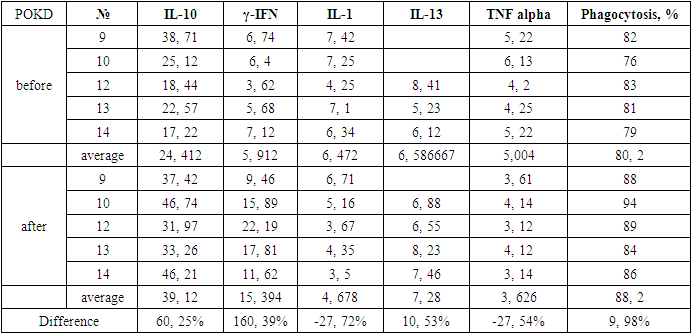-
Paper Information
- Next Paper
- Paper Submission
-
Journal Information
- About This Journal
- Editorial Board
- Current Issue
- Archive
- Author Guidelines
- Contact Us
American Journal of Medicine and Medical Sciences
p-ISSN: 2165-901X e-ISSN: 2165-9036
2025; 15(2): 334-336
doi:10.5923/j.ajmms.20251502.15
Received: Jan. 22, 2025; Accepted: Feb. 11, 2025; Published: Feb. 14, 2025

Immunoparasitan-N and Study of Its Immunomodulating Indicators
Mamatkulov Behzod Ibragimovich1, Zakirov Mukhsim Mukhtarovich2, Ignatov Petr Evgenyevich3
1Doctorant of the Tashkent Research Institute of Vaccines and Serums, Tashkent, Uzbekistan
2Associate Professor, PhD of the Tashkent Medical Academy, Uzbekistan
3Doctor of Biological Sciences, Professor, Director of the Company "IGN-International", Uzbekistan
Copyright © 2025 The Author(s). Published by Scientific & Academic Publishing.
This work is licensed under the Creative Commons Attribution International License (CC BY).
http://creativecommons.org/licenses/by/4.0/

The authors studied the main characteristics of the drug Immunoparazitan, intended for use in veterinary medicine. Its use in the conditions of the Republic of Uzbekistan demonstrated its antiparasitic protective effectiveness and low toxicity. By modifying it, it was possible to significantly improve its characteristics, which made it possible to design a new drug Immunoparasitan-N. Toxicological and immunobiological parameters were studied for the use of this drug in medical practice.
Keywords: Parasitosis, Immunomodulators, Immunity, Immunoparasitan-N
Cite this paper: Mamatkulov Behzod Ibragimovich, Zakirov Mukhsim Mukhtarovich, Ignatov Petr Evgenyevich, Immunoparasitan-N and Study of Its Immunomodulating Indicators, American Journal of Medicine and Medical Sciences, Vol. 15 No. 2, 2025, pp. 334-336. doi: 10.5923/j.ajmms.20251502.15.
1. Introduction
- Based on the properties of the Immunoparasitan preparation, we developed a more advanced version of it, which was already suitable for use in medical practice. In a number of preliminary experiments, we studied the veterinary preparation Immunoparasitan, which contained 0.3% formaldehyde as a preservative. This is quite common for veterinary drugs, but completely unacceptable for medical drugs.
2. Objectives
- First of all, when developing a medical drug, we replaced the preservative, since the formaldehyde used in the original version was unacceptable. After a small screening, expressed in the analysis of various preservatives, such a well-known and positively proven preservative as merthiolate was chosen [7]. The preservative in various doses - 50, 100 and 150 mcg / ml was added to Immunoparasitan, after which such a drug was placed in a thermostat at a temperature of 37 degrees Celsius for 10 days. As a result, the optimal dose of the preservative was selected, at which the germination of the drug by foreign microflora was not observed. This dose was 100 μg/ml.In addition, beta-1,3/1,6-glucan was used as an adjuvant or secondary immunomodulator in the Immunoparazitan drug. And although such polymers are used in medicine (for example, zymosan, which has long been used in medical practice), their injections are quite painful for humans and can cause adverse reactions at the injection site. Therefore, it was decided to replace this secondary immunomodulator with a highly soluble tissue lysate drug [3], the immunomodulatory properties of which are well known. Its oral analogue (Immun-5) has been produced and used in medical practice in the Republic of Uzbekistan for more than 20 years.As a result of the experiments, it was found that the most optimal dose of the secondary immunomodulator is a tissue lysate dose of 2 mg/ml. Thus, based on the materials of the conducted experiments, we created a new drug, which was named Immunoparasitan-N, i.e. “Human”.
3. Methods
- The study of the phagocytic activity of the Immunoparasitan-N drug was conducted on a rabbit model. Ten days after the treatment of the animals, heparinized blood was obtained from them, which was then incubated for 2 hours with finely dispersed particles of chitin and an aqueous solution of nitroblue tetrazolium (NBT test). Similar groups of rabbits treated with Polyoxidonium and physiological NaCl solution (control) were used as a comparison [2].As the results of the experiment showed, the rabbits treated with Immunoparasitan-N showed the greatest phagocytic activity with respect to chitin particles. The phagocytic number in this group was 11.7 +/- 2.1. Accordingly, the intensity of the respiratory burst, accompanied by intensive production of superoxide radicals, was the highest in this group (12.3 +/- 2.7). Polyoxidonium had significantly lower activity in relation to these indicators (7.4 +/- 1.9 and 9.1 +/- 1.7, respectively). The activity of phagocytes in the control, first group in relation to chitin particles was the lowest and amounted to 6.2 +/- 1.8 in terms of phagocytic number and 4.3 +/- 1.5 in terms of the NST test.
4. Results
- Thus, it follows from the experiment that the Immunoparazitan-N preparation has a pronounced ability to increase phagocytic activity and enhance the production of superoxide anions by the body's cells. When studying the cytokine profile induced by the introduction of Immunoparazitan-N, rabbits that were injected with an equal volume of isotonic saline (Group 1) and rabbits treated with the immunomodulator polyoxidonium (Group 3) were also used as a control. Each group had 5 rabbits. In addition, neutrophil phagocytosis was also studied in this experiment, but staphylococcal cells were used as targets.Study of the cytokine profile induced by the administration of the drug Immunoparasitan-N.In this experiment, rabbits were also used, from which 15 days after the introduction of Immunoparazitan N, blood was taken and examined for the content of proinflammatory (IL-1, TNF-alpha) and antiinflammatory (IL-10), as well as other immunoactive (IL-13 and IFN-gamma) cytokines. As a control, rabbits were used that were administered an equal volume of isotonic saline (group 1) and rabbits treated with the immunomodulator Polyoxidonium (group 3). In addition, the initial indicators in the groups, before the start of the experiments, served as a certain control.There were 5 rabbits in each group. In addition, in this experiment, neutrophil phagocytosis was also studied, but staphylococcal cells were used as targets. The results of this experiment are presented in Tables 1, 2, 3.
|
|
|
5. Discussion and Conclusions
- As follows from the results of the experiment, the introduction of Immunoparazitan-N has virtually no effect on the levels of anti-inflammatory IL-10, the concentration of which very often increases in chronic parasitic infections. At the same time, the production of interferon gamma increases significantly, which may indicate the activation of killer abilities in macrophages, NK cells, T cells, eosinophils, etc. This is a very important indicator that plays a significant role in the antiparasitic immune response. In terms of the intensity of production of this cytokine, Immunoparazitan-N exceeds the indicators of the well-known immunomodulator Polyoxidonium.As for the pro-inflammatory cytokines IL-1 and TNF-alpha, we can say that their levels are slightly reduced both in the Immunoparazitan N group and in the Polyoxidonium group compared to the control [6]. This is somewhat strange, but this effect may be associated with the effect of a general decrease in these cytokines in rabbits of all groups at this time (see groups 1; 2 and 3). At the same time, a slight increase in the amount of IL-13 is noted, both in group 2 and in group 3. This interesting interleukin, with properties that have not been fully elucidated, takes an active part not only in the development of antiparasitic immunity, but also in the induction of various allergic reactions of the body [4]. It should be emphasized once again that the increase in its concentration is quite insignificant.The study of phagocytosis activity in this experiment confirmed the results of the previous experiment on the pronounced ability of Immunoparazitan to stimulate phagocytosis, although to a lesser extent than chitin targets [1]. Activation of phagocytosis was also noted in the Polyoxidonium group.Thus, the conducted study of the dynamics of the synthesis of some cytokines, as well as the phagocytic and killer activity of phagocytic cells [5], indicate that the introduction of Immunoparazitan N can enhance the antiparasitic mechanisms of the body's immune response. At the same time, proinflammatory and allergenic mechanisms are not sharply activated and remain within normal values.
 Abstract
Abstract Reference
Reference Full-Text PDF
Full-Text PDF Full-text HTML
Full-text HTML

